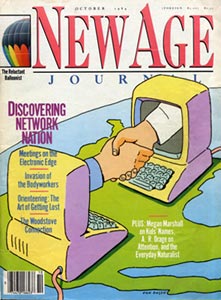Network Nation

A quarter century ago I wrote a cover story about the embryonic “Network Nation” that was dawning online. At that time (in 1984) there was only the barest glimmer of what we see now. It was a decade before the arrival of the web, years before there was a publicly accessible internet, and a few years before the WELL. A more precise title of my article might have been “Network Archipelago” because each new-born online destination was quite isolated from the rest.
I was a travel columnist at New Age Journal, where this piece was published. I treated these small outposts of new cultures as if they were the first emerging tips of a rising new continent, and I was visiting them to write a travel guide.
Here’s the first paragraph:
Take a flashlight and peer into the little square hole where your telephone plugs into the wall. See those four colored wires way in the back? Those strips of copper are holding back the waters of network nation. Define a network as at least two computers linked together, usually via telephone wires; the network nation is a web of people stretching from Bar Harbor to San Diego, from Seattle to St. Petersburg, linked electronically to one another through the medium of their computers. At this moment, in the pattern of the jiggly electrons pooled behind your telephone plug, minds meet without bodies, commute to work, and visit friends. This kaleidoscopic networking is done with dinky computers or sleek $3,000 machines. Computer neighbors can leave notes or write stories and news to each other, which can be read on the computer screen anytime; these messages can be strictly private or made public for everyone to discuss.
One from the middle:
The thing I grow to love about EIES is that it is a place to meet, perhaps like the cafes of old Paris. It’s the kind of place we haven’t had in our time, the sort of spot American bars wish they were, and what churches used to be. We yearn for a common ground to rest on and to refigure the events of the day, to chat, and to make fun without having to explain too much. The friends we’d like to live in our neighborhood live instead in Dallas or St. Paul or Phoenix. But on the networks, we all meet in green computer light no matter where we are. Every evening I can log into the electronic cafes of EIES and spend an hour with friends, trading news, listening, and laughing.
And near the end;
What can I say about computers while standing in the dappled sunlight of a golden spring day, and still be honest? The truth is that telecommunicating is still slow, cumbersome, and expensive. Worse, no two systems are the same. Every bulletin board or data bank has its own idiosyncratic layout, a different protocol, a different dialect. At the same time, it’s hard to lose a grip on the computer dream: networks of small computers flashing our intelligence along the surface of the globe just as our thoughts surge along the membrane of our cerebrum.
Re-reading the report 25 years later I am struck by how small that early world was. I visited just about every place online at that time. Each node was thin, only active part time. Today the online world is so vast that I’d have trouble visiting all the pages on my own website, let alone even begin to map the internet out.
What I got right: The variety, diversity, and fullness of relationships, emotion, engagement, and creativity possible online. At the time computers had the reputation of being cold, sterile, anti-social machines, and I tried to convey the powerful social dimension they contained. I think that came across.
What I got wrong: Always on. More than once in the article I noted folks who logged on “every day.” I had no sense that we would be online all our waking hours. I gave no hint that moving from one place to the next would be a simple click instead of having to redial a phone number. Or that we’d be online via mobile phones, without dialing! I wrote about the network as an exotic destination with no appreciation that it would simply become our home address. That seemed too much to believe.
The full piece can be read here in legible text, or in this PDF.


